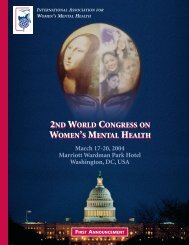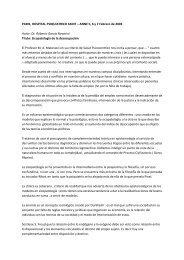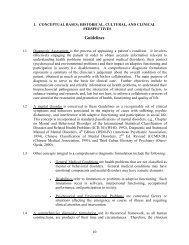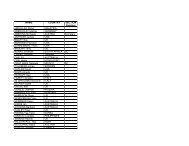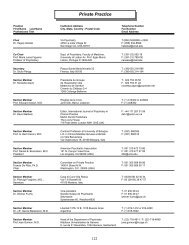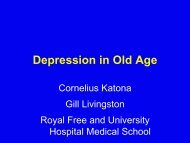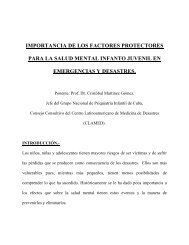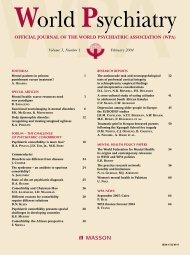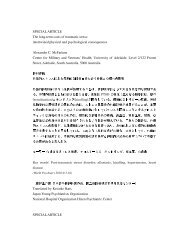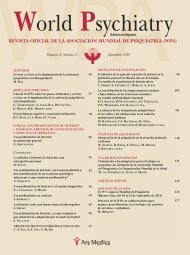ABSTRACTS - World Psychiatric Association
ABSTRACTS - World Psychiatric Association
ABSTRACTS - World Psychiatric Association
Create successful ePaper yourself
Turn your PDF publications into a flip-book with our unique Google optimized e-Paper software.
services other than health; the question of how best to prevent the<br />
abuse of the classification of mental disorders; and many others. We<br />
present these and other issues and problems and describe what has<br />
been done to resolve them.<br />
US8.2.<br />
TOWARDS MENTAL AND BEHAVIOURAL<br />
DISORDERS IN ICD-11: WHO´S VISION AND PLANS<br />
S. Saxena, G.M. Reed<br />
Department of Mental Health and Substance Abuse,<br />
<strong>World</strong> Health Organization, Geneva, Switzerland<br />
The <strong>World</strong> Health Organization (WHO) is revising the International<br />
Statistical Classification of Diseases and Related Health Problems<br />
(ICD-10), accepted by the <strong>World</strong> Health Assembly in 1990. The inclusion<br />
of mental disorders alongside other diagnostic entities is an<br />
important feature of the ICD, facilitating the search for related mechanisms<br />
of etiology, pathophysiology, and comorbidity, and providing<br />
a basis for parity of mental disorders in clinical, administrative, and<br />
financial policies and functions in health care. Over the past two<br />
decades, research in genetics, neuroscience, epidemiology, and cognitive<br />
and behavioural sciences has made critical advances in understanding<br />
the nature and treatment of mental disorders. The revision of<br />
ICD-10 Chapter V: Mental and Behavioural Disorders must use this<br />
new knowledge to address systemic limitations. At the same time, the<br />
classification must be responsive to WHO’s public health mission and<br />
its three core constituencies: member states, multidisciplinary health<br />
professionals, and users of mental health services. The revision<br />
process is focusing attention on usability and usefulness of the classification<br />
within primary health care settings, where the vast majority of<br />
all care for people with mental disorders is provided. The simultaneous<br />
requirements of scientific validity and clinical utility have led<br />
WHO to establish a multidisciplinary revision process that focuses on<br />
global scientific evidence, worldwide clinical utility, and cross-cultural<br />
applicability. A web-based revision platform for receiving suggestions<br />
is functioning and plans for field trial are being developed. The<br />
ICD revision is also being harmonized with DSM revision being<br />
undertaken simultaneously by the American <strong>Psychiatric</strong> <strong>Association</strong>.<br />
US8.3.<br />
ON THE ROAD TO DSM-V AND ICD-11<br />
D.J. Kupfer<br />
Department of Psychiatry, University of Pittsburgh School<br />
of Medicine, Western <strong>Psychiatric</strong> Institute and Clinic, Pittsburgh,<br />
PA, USA<br />
Many scientific and methodological advances made in the last two<br />
decades could play an important role in the DSM-V and ICD-11. In<br />
order to facilitate their inclusion in the next nomenclature, a research<br />
agenda developed in concert with the American <strong>Psychiatric</strong> <strong>Association</strong>,<br />
National Institutes of Health, and <strong>World</strong> Health Organization is<br />
providing new approaches and stimulating the empirical research<br />
toward that end. The goals of this effort include: a) ensuring greater<br />
clinical utility and relevance; b) utilizing a developmental approach<br />
across the life span; c) incorporating new knowledge from the neurosciences<br />
and the behavioral sciences in elucidating risk factors and<br />
prodromal features of disorders; and 4) adopting methodological<br />
strategies utilizing both dimensional and categorical approaches. We<br />
provide a brief review of the recommendations developed from the<br />
thirteen international planning conferences held between 2003 and<br />
2008. As the Task Force for DSM and specific disorder Workgroups<br />
begin their activities, specific cross-cutting issues are being addressed.<br />
These issues include the following topics: a) life span developmental<br />
approaches; b) diagnostic spectra; c) psychiatric/general medical<br />
interface; and d) gender and cross-cultural expression. Other important<br />
concepts and strategies for alignment with ICD-11 activities will<br />
also be discussed that seek to promote international collaboration<br />
among members of the scientific and clinical communities.<br />
US9.<br />
GENDER-RELATED ISSUES IN PSYCHIATRIC<br />
TREATMENTS<br />
US9.1.<br />
TREATMENT OF DEPRESSION<br />
IN PERIMENOPAUSAL WOMEN<br />
D.E. Stewart<br />
University Health Network, University of Toronto, Canada<br />
Depression is approximately twice as common in women between the<br />
ages of puberty and menopause as in men. Although most epidemiologic<br />
studies do not show a spike in depression rates in women at<br />
midlife, it is now evident that certain women are at greater risk of<br />
depression during perimenopause (the transitional years). Risk factors<br />
for depression in perimenopause include previous depression, premenstrual<br />
dysphoric disorder and possibly postnatal depression and<br />
rapid hormonal changes. The menopausal transitional stages have<br />
been defined by STRAW (Stages of Reproductive Aging in Women).<br />
The associated physical, psychological (including mood and anxiety)<br />
and cognitive symptoms of perimenopause have multifactorial etiologies,<br />
including biological, hormonal and psychosocial cultural factors.<br />
Biologic mechanisms for the symptoms of perimenopause include<br />
ovarian aging and subsequent reductions in estradiol. Theories on the<br />
pathophysiology of thermoregulation and its dysfunction are changing.<br />
The effects of neuromodulators on the hypothalamus and other parts<br />
of the central nervous system play a major role in psychological symptoms.<br />
The effects of estrogen on the serotonergic and noradrenergic<br />
systems and the resulting effects on mood and anxiety during perimenopause<br />
are greater when changes occur rapidly. The socio-cultural<br />
context of the menopausal transition and aging are backdrops of all<br />
biological mechanisms and should not be overlooked. Recommendations<br />
for the assessment and management of depressive symptoms and<br />
depression during perimenopause will be based on recent studies. In<br />
summary, antidepressants and evidence based psychotherapies remain<br />
the treatments of choice, but estradiol supplementation may be efficacious<br />
in perimenopausal women with treatment resistant depression.<br />
US9.2.<br />
TREATING A WOMAN WITH AN UNWANTED<br />
PREGNANCY<br />
N.L. Stotland<br />
Rush Medical Center, Chicago, IL, USA<br />
Helping women making decisions about problem pregnancies<br />
requires therapeutic neutrality and a personal review by the patient of<br />
her values, religion, circumstances, and expectations. The psychiatrist<br />
may have strong personal feelings about the suitability of a patient for<br />
motherhood and must take care not to impose these on the patient.<br />
Mental illness, in and of itself, is not a contraindication to parenting,<br />
but may call for specialized social supports. Should a patient contemplate<br />
terminating the pregnancy, it is important to counter widely<br />
held public misconceptions, and inform her that negative physical<br />
and psychological sequelae of abortion are far less common than<br />
13



